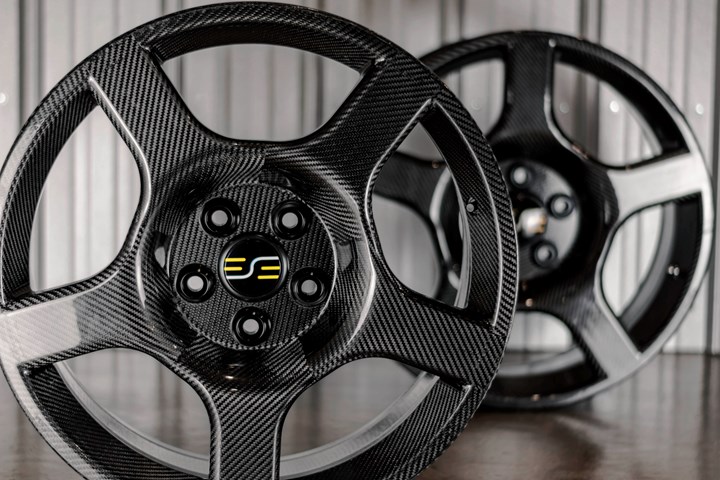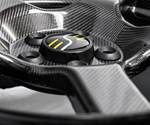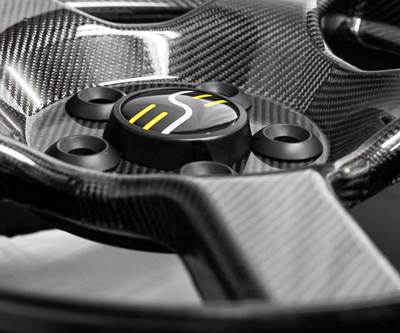ESE carbon fiber wheels launch to aftermarket segment
The E2 wheels, built from a combination of tailored fiber placement preforming with resin transfer molding, are available for select vehicles after passing stringent lab and field testing.

ESE Carbon Co. (ESE, Miami, Fla., U.S.) recently launched its E2 one-piece carbon fiber composite wheels into the market for the aftermarket segment. The initial E2 launch includes 19 x 8.5-inch wheels, servicing Tesla Model S, Tesla Model 3 and Subaru WRX STI vehicles.
The wheels, which CW wrote about in 2020, use tailored fiber placement (TFP) and high-pressure resin molding (RTM) to produce a lightweight, single-piece, high-performance wheel. Since CW last wrote about the wheels, ESE has completed its transition from initial autoclave processing to an improved RTM process using heated tooling. The resin and tooling are said to be preheated, with carefully controlled resin flow during infusion. Improvements have also been made to the TFP stitching process, to improve productivity as well as wheel mechanical properties. Small ply changes have been made to the E2s to ready them for market, to improve layup consistency, appearance and wheel test performance, and a clear coat solution has been finalized. The mounting hardware has also been refined to improve lug torque retention.
The wheels have been a four-year process to develop and test, ultimately passing stringent fatigue and impact tests set by the Society of Automotive Engineers’ (SAE) Recommended Practices for wheels.
According to ESE and a recent whitepaper produced by the company, SAE recommended practices such as SAE J328 for vehicle wheels, SAE J2530 for aftermarket wheels, SAE J2562 for biaxial wheels, and SAE J175 for road vehicle wheels were originally designed to test traditional metal wheels. The E2s were able to pass all tests required of SAE, due to the wheels’ rigorous engineering analysis and testing during development, the company says.
Dr. Michael Hayes, ESE Carbon’s VP, head of engineering, served on an SAE committee in 2020 to develop new recommended practices specific to fiber-reinforced composite wheels.

The resulting SAE J3204 adapts the Recommended Practices for metal wheels to composite wheels, imposing new requirements such as strength reduction factors (SRFs) to account for environmental effects, maximum operating temperature testing, and electricity conductivity testing.
ESE emphasizes that its E2 wheels have also been proven to withstand impact at very cold temperatures, above and beyond the requirements. The company conducted its own independent lab testing to test curb and pothole impact at -40°C. The company says its wheels were not affected by the cold temperatures at all, thanks to specially developed wheel flanges designed with a high percentage of circumferentially oriented carbon fiber to maximize hoop strength. This strength is said to be great enough to enable the circumferential plies to be “nearly insensitive” to cold temperatures. “We have taken great care to design very robust flanges in our wheels,” Dr. Hayes explains. “In addition, because of the superior strength-to-weight ratio of carbon fiber composites, we can increase the size of the flanges to further increase impact strength without a weight penalty.” The TFP process allows for production of circular plies at a high fiber volume fraction.
See ESE’s whitepaper for more information.
Related Content
Troubleshooting thermal design of composite battery enclosures
Materials, electrical insulation and certification are all important factors to consider when optimizing electric battery performance against potential thermal runaway.
Read MoreInfinite Composites: Type V tanks for space, hydrogen, automotive and more
After a decade of proving its linerless, weight-saving composite tanks with NASA and more than 30 aerospace companies, this CryoSphere pioneer is scaling for growth in commercial space and sustainable transportation on Earth.
Read MoreMaterials & Processes: Composites fibers and resins
Compared to legacy materials like steel, aluminum, iron and titanium, composites are still coming of age, and only just now are being better understood by design and manufacturing engineers. However, composites’ physical properties — combined with unbeatable light weight — make them undeniably attractive.
Read MoreMulti-material steel/composite leaf spring targets lightweight, high-volume applications
Rassini International was challenged by Ford Motor Co. to take weight out of the F-150 pickup truck. Rassini responded with a multi-material steel/composite hybrid leaf spring system that can be manufactured at high volumes.
Read MoreRead Next
One-piece, one-cure, infused carbon fiber wheel is ready to roll
ESE Carbon Co.’s new carbon fiber wheel uses tailored fiber placement and custom presses to minimize waste and improve scalability.
Read MoreFrom the CW Archives: The tale of the thermoplastic cryotank
In 2006, guest columnist Bob Hartunian related the story of his efforts two decades prior, while at McDonnell Douglas, to develop a thermoplastic composite crytank for hydrogen storage. He learned a lot of lessons.
Read MoreCW’s 2024 Top Shops survey offers new approach to benchmarking
Respondents that complete the survey by April 30, 2024, have the chance to be recognized as an honoree.
Read More
.jpg;width=70;height=70;mode=crop)









.jpg;maxWidth=300;quality=90)















